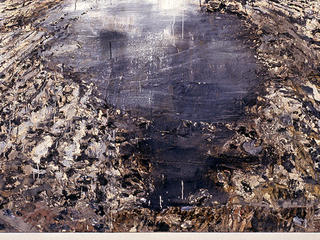 [Excerpts from The Exegesis of Mogen David ben Chatterjee, the Mad Jew of Calcutta, appear in italics.]
[Excerpts from The Exegesis of Mogen David ben Chatterjee, the Mad Jew of Calcutta, appear in italics.]Art transforms us because it shatters, or at least rearranges, our symbol systems. Religion should do this, too, but we all know how that goes. Why did Kali--or was it Laura?--or Ammachi?--or blind chance?--lead me to that Kiefer painting, hanging beside a sculpture by the same artist called Angel of History? (OK, it's a B-52 bomber, but I still appreciate the seraphic synchronicity...after all, by my own admission, I'd come to DC seeking answers about "the light and dark sides of my Mother Kali--pleasure and pain, love and violence, beauty and horror.")
On the painting's name/meaning: usually transliterated "tzimtzum"...get this, from Daniel Matt's The Essential Kabbalah (the one book everyone should read on this subject)--page 93, no less:
In the words of Shabbetai Sheftel Horowitz, 17th-century wise guy, "Before the creation of the world, Ein Sof withdrew itself into its essence, from itself to itself within itself. It left an empty space within its essence, in which it could emanate and create."
This space is the tzimtzum. Some of its earthly analogues are the Ark of the Covenant, the Grail, the heart chakra, the Mandelbrot Set...there's at least one more...
In our Divine Mother's original act of self-love, when pure consciousness noticed Itself and swoon'd in delight--a space opened in which everything could happen. And is happening--wave on wave of happening on the face of the waters. What did Amma say? Something to the effect that no true separateness exists--Kali is an infinite ocean on which we and all we know are wavelets and waves. This is the form in which Ramakrishna perceived Her after begging and begging for a vision; it's a lot like what I saw when Amma hugged me the first time.
Kabbalah's "shattered vessels" become, in Shaktism, Mother Kali's divine play (lîlâ)...play forms a part of Her essential nature, which I suppose is why Kali, in traditional Shakta iconography, is a sexy young woman who also happens to carry a sword. In Judeo- Christianity, what we call good, evil, creation, destruction, etc. reflect a lost unity that will one day be restored. In Shaktism, these appear as manifestations of Kali's play...is that a picture of a stagnant, forboding pool, or of a sweet beginning of beginnings?
...or--for now, anyway, this is the "strong and delicious word which...the sea whisper'd me."

"...withdrew itself into its essence, from itself to itself within itself" -- made me think of one of the Rig Veda passages about Agni: sacrificing the sacrifice to the sacrifice. Which I loved.
ReplyDeleteI first read of the Ein Sof in Gershon Scholem's Kabbalah almost 20 years ago and it's one of the concepts of the Divine I like to use in my own meditations. And "Yichud" -- unity, oneness.
Hmmm -- wasn't life on Earth supposed to have begun in a stagnant pool? (Grin.)
Hmmm -- wasn't life on Earth supposed to have begun in a stagnant pool? (Grin.)
ReplyDeleteI know--I was reflecting on my many past lives as algae this morning ;)...thank you for this great response. Gives me a lot to think about...